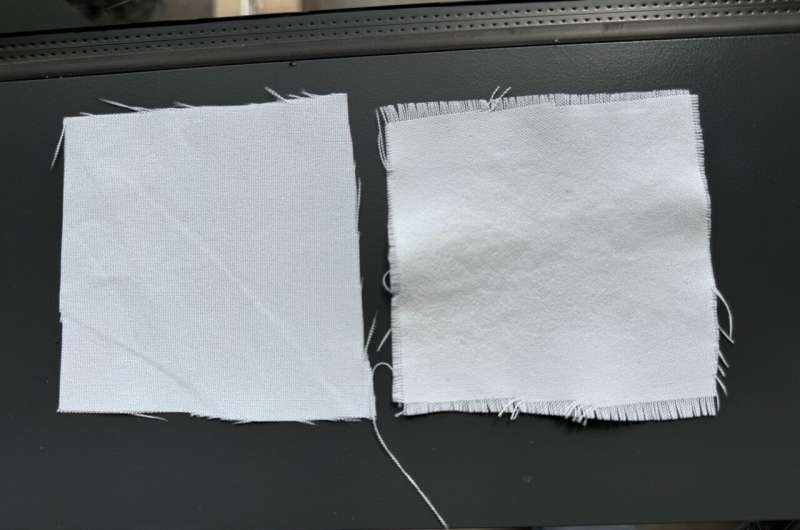
In the scorching heat of summer, anyone who spends time outside—athletes, landscapers, kids at the park or beachgoers—could benefit from a cooling fabric. While there are some textiles that reflect the sun’s rays or transfer heat away from the body, current options require boutique fibers or complex manufacturing processes. But now, researchers report a durable chalk-based coating that cools the air underneath treated fabric by up to 8 degrees Fahrenheit.
Evan D. Patamia, a graduate student at the University of Massachusetts Amherst, will present their team’s results at the fall meeting of the American Chemical Society (ACS). ACS Fall 2024 is a hybrid meeting being held virtually and in person from Aug. 18–22; it features about 10,000 presentations on a range of science topics.
“If you walk out into the sunlight, you will get increasingly hot because your body and clothing are absorbing ultraviolet (UV) and near-infrared (near-IR) light from the sun,” says Trisha L. Andrew, a chemist and materials scientist working with Patamia. “And as long as you’re alive, your body is generating heat, which can be thought of as light, too.”
To make people more comfortable outside, scientists have been developing textiles that simultaneously deflect the sun’s rays and push out natural body heat—a process known as radiative cooling. Some of those materials have light-refracting synthetic particles, such as titanium dioxide or aluminum oxide, embedded into spun fibers. Others use organic polymers, such as polyvinylidene difluoride, which require perfluoroalkyl and polyfluoroalkyl substances, known as PFAS or forever chemicals, in their production processes to create light-reflective textiles.
But scaling the manufacturing of these materials for commercialization isn’t sustainable, according to Andrew. So, she posed the question to research team members Patamia and Megan K. Yee, “Can we develop a textile coating that does the same thing using natural or environmentally benign materials?”
Previously, Andrew and colleagues created a simple technique to apply durable polymer coatings on fabric called chemical vapor deposition (CVD). The method combines synthesis and deposition into the same step: grafting a thin polymer layer onto commercial textiles with fewer steps and less environmental impact than other ways to attach coatings.
So, inspired by the crushed limestone-based plasters used historically to keep houses cool in extremely sunny places, Patamia and Yee worked on innovating a process to integrate calcium carbonate—the main component in limestone and chalk—as well as bio-compatible barium sulfate onto the polymer applied by CVD. Small particles of calcium carbonate are good at reflecting visible and near-IR wavelengths, and barium sulfate particles reflect UV light.
Treating small squares of fabric, the researchers applied a 5-micrometer-thick poly(2-hydroxyethyl acrylate) layer and repeatedly dipped the polymer-treated squares into solutions containing calcium or barium ions and solutions containing carbonate or sulfate ions.
With each dip, the crystals become larger and more uniform, and the fabric develops a chalky, matte finish. Patamia says that by changing the number of dipping cycles, the particles can be tuned to reach the ideal size distribution (between 1 and 10 micrometers in diameter) for reflecting both UV and near-IR light.
The researchers tested the cooling abilities of treated and untreated fabrics outside on a sunny day when the temperature measured more than 90 F. They observed air temperatures underneath the treated fabric that registered 8 F cooler than the ambient temperature in the middle of the afternoon. The difference was even greater, a maximum of 15 F, between treated and untreated fabric, which heated the air underneath the sample.
“We see a true cooling effect,” says Patamia. “What is underneath the sample feels colder than standing in the shade.”
As a final evaluation of the mineral-polymer coating, Yee simulated the friction and impact of laundry detergent in a washing machine. She found that the coating didn’t rub away and the material retained its cooling ability.
“So far in our processes, we’ve been limited by the size of our laboratory equipment,” says Andrew. But she’s part of a startup company that’s scaling the CVD process for bolts of fabric, which are about 5 feet wide and 100 yards long. Andrew explains that this venture could provide a way to translate Patamia and Yee’s innovations into pilot-scale production.
“What makes our technique unique is that we can do this on nearly any commercially available fabric and turn it into something that can keep people cool,” concludes Patamia. “Without any power input, we’re able to reduce how hot a person feels, which could be a valuable resource where people are struggling to stay cool in extremely hot environments.”
Citation:
Chalk-based coating creates a cooling fabric (2024, August 21)
retrieved 21 August 2024
from https://phys.org/news/2024-08-chalk-based-coating-cooling-fabric.html
This document is subject to copyright. Apart from any fair dealing for the purpose of private study or research, no
part may be reproduced without the written permission. The content is provided for information purposes only.

